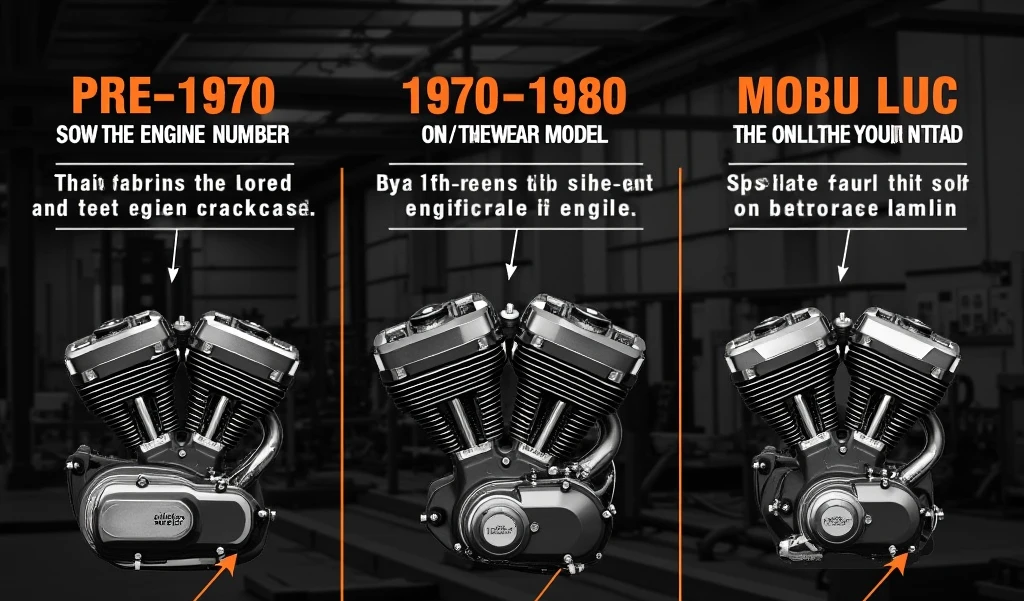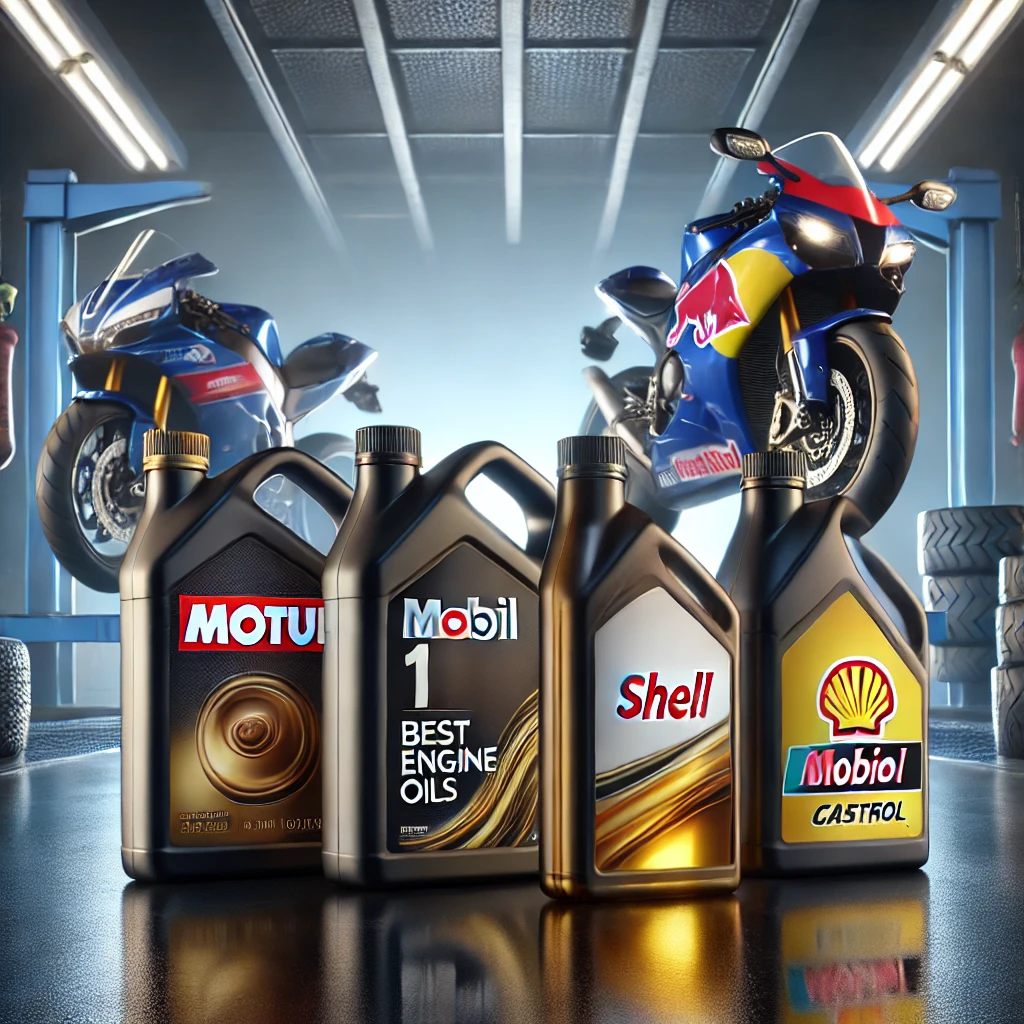Understanding Harley-Davidson Engine Numbers
Engine numbers are one of the fundamental keys to identifying, verifying, and accessing the historical record of your Harley-Davidson motorcycle.
So, whether you are a Harley owner, collector, mechanic, or buyer, if you want to find out–everything from the year it was made to the model of the bike to whether it is real and what market it was aimed at, you need to know where to find these numbers, how to read them, and how to decode them.
I know a lot of Harley aficionados mix up the engine number with the VIN, but they mean different things. The VIN (Vehicle Identification Number) is a unique identifier stamped on the motorcycle’s frame and used for legal registration.
In contrast, the engine number is a separate identifier assigned to the engine itself. That’s important because, in most scenarios, the engine has been swapped or rebuilt somewhere down the line.
Why Are Harley-Davidson Engine Numbers Important?
Harley numbers do die tty sweet; they tell more than just some random digits; they tell how the motorcycle was produced, what kind of engine it is, and possibly how original a Harley is. Here is why you need to understand them:
- Motorcycle ID: This is essential for identifying exactly which model and year of Harley-Davidson you have.
- Validate the Authenticity: Your engine has not been replaced or manipulated.
- Check for Stolen Bikes: Prevents purchasing of stolen or illegally modified motorcycles.
- Restoration & Resale Value: IMPORTANT (for those restoring vintage Harleys)
- DMV & Insurance Records: Engine number verification could be mandatory while taking registration in some states.
What You’ll Learn in This Guide
We here at Cycle World have put together a massive guide of everything you need to know about Harley-Davidson engine numbers, including:
- What is the location of the engine number on the Harley motorcycle
- Understanding & Deciphering Harley Engine Numbers
- What distinguishes VIN vs Harley engine numbers?
- Related The Harley Engine Numbers Explained: How to Verify One
- How to check if a Harley engine number is stolen
- FAQs for Engine Numbers Problems & Solutions
At the end of this guide, you will possess the knowledge to decode, verify, and understand your Harley Davidson engine number confidently. Let’s get started!
What Are Harley-Davidson Engine Numbers?
Harley-Davidson engine numbers are identifiers given to every motorcycle engine made, with each number being unique based on when the heart of a Harley was manufactured.

These numbers are essential to learning a motorcycle’s history, checking its authenticity, and distinguishing it from similar models. Many people mistook the engine number for a VIN (Vehicle Identification Number); however, an engine number has a particular meaning and structure.
The Purpose of Harley-Davidson Engine Numbers
Engine number gives you some idea about motorcycle, such as
• Manufacture information — Year and plant where the engine was manufactured.
• Find the Harley-Davidson model
• Ownership verification Used for registration and theft prevention in the records
• Mechanical Complementarity – Helps to find complementary components for repairs and adaptations.
Its chassis number is a permanent identifying mark; the engine number can vary depending on the motor. Your motorcycle might have the exact VIN stamped on the frame as the engine could be swapped. Still, due to its engine number, it would identify as a different motorcycle.
An engine is also a popular aftermarket component. If an original engine is replaced, the new engine will feature a different number, making it one of the key elements to verify whether a motorcycle retains its original components.
How Harley-Davidson Engine Numbers Have Changed Over Time
Harley-Davidson has used various numbering systems in the past. Most of these changes were made to make the car more secure, easier to track, and easier to manufacture.
Pre-1970 Engine Numbers
Before 1970, Harley-Davidson punched the engine number into the crankcase on the left side.
- In the case of motorcycles, these numbers were the primary identifiers of the vehicle.
- In some states, it was also used to register details.
1970-1980 Transition Period
- Harley-Davidson started stamping VINs on the frame in 1970.
- Engine numbers were still used but were not the primary number for legal registration.
So many models of this era have mismatched engines and VINs that it can be confusing to authenticate a bike.
Engine Number System from 1981 to Present
- Harley-Davidson used a standardized 17-digit VIN starting in 1981 per international standards.
- Engine number and VIN no longer matched (VIN became the primary identifier)
- An engine number still exists, primarily used to identify manufacturing and service records rather than registration.
Key Differences Between Harley-Davidson Engine Numbers and VIN
| Feature | Engine Number | VIN Number |
| Location | Stamped on the engine crankcase | Stamped on the motorcycle frame |
| Purpose | Identifies the engine itself | Identifies the entire motorcycle |
| Used for Registration? | No (except pre-1970 models) | Yes |
| Can It Change? | Yes, if the engine is replaced | No, remains with the frame |
Knowing engine numbers is very important if you’re a Harley-Davidson enthusiast — especially if you’re buying a used motorcycle or restoring an older model. These numbers provide information on a bike and ensure it has not been illegally changed or used in illegal works.
Where to Find the Engine Number on a Harley-Davidson?
A Harley-Davidson motorcycle’s engine number is a vital identifier for verifying its authenticity, model year, and manufacturing details. Harley-Davidson has changed where engine numbers are placed over many years , making it essential to know where to look depending on the model and production year.
Ways to Find Harley Davidson Engine Number Locations
Over the years, Harley-Davidson has used various locations for engine numbers. Here are several of the most conventional placings:
Pre-1970 Harley-Davidson Models:
- The engine number is most commonly stamped on the left side of the engine crankcase.
- Since VINs were not standardized, these numbers were often used as the official identification for registration.
1970 to 1980 Models:
- From this period, Harley-Davidson stamped engine numbers on the right side of the engine crankcase.
- The VIN system began taking hold in 1970, but engine numbers remained a central identification element.
1981 and Newer Models:
- Starting in 1981, Harley-Davidson ceased matching engine numbers with frame VINs.
- The vehicle identification number (VIN) is located in the frame neck (steering head). See below for the location.
- Engine No: While still found near the bottom of the proper engine case, it is no longer the primary identification number for legal documentation.

How to Find and Read the Engine Number
Locate the engine number on your Harley-Davidson using the following process:
Ensure good lighting: Engine numbers can be small and lightly stamped, making them hard to see.
Clean the area: a cloth will remove dirt or oil that might mask the stamping.
Inspect the steering neck. While the engine number differs from the VIN, cross-checking both can help verify authenticity.
Your Owner’s or Service Manual can also help check if the engine number is correctly placed if wear or modifications make it unclear.
How to Read and Decode Harley-Davidson Engine Numbers?
The Harley-Davidson engine numbers of motorcycle factories have followed a particular, evolving format over the following decades. Each engine number contains valuable information about the specific motorcycle, including model year, engine type, and even its place of manufacture.
Here’s a way to unpack and make sense of the information encoded in these numbers.
Understanding the Harley-Davidson Engine Number System
The engine number usually contains multiple characters, each with its significance. While the format was more straightforward in early models, Harley-Davidson has gradually revised how it codes these numbers over the decades.
Now, it covers numeric and alphabetic characters and tells us much about the bike.
Decoding the Engine Number
Let’s decode a typical Harley-Davidson engine number as an example:
• Engine Number Example: 6A-XXX-123456
1. The First Digit (Year Code):
- The model year is typically the first character or digit. Over the years, Harley-Davidson has implemented various numbering systems, but the numbers usually indicate the year the motorcycle was produced.
- For example, “6” may refer to a 1966 model or some other pertinent year, depending on the era.
2. The Letters (Type and Model of Engine):
- The engine type and model series letters are in the middle section of the engine numbers number. So, “A” could refer to a particular model, such as the ”Sportster” or some other common type of Harley.
3. The Last 3 Digits (S/N):
- The end of the number is given in a series of numbers, referred to as a string, which corresponds to that specific bike’s serial number identification. This is a helpful way to tell one Harley-Davidson apart from another despite being the same model year and engine type.
Common formats of Harley Davidson engine number
• Pre-1970s:
- In the early years, Harleys had a much simpler numbering system, generally not more than a few numbers and letters indicating the model and year of manufacture. For example, a “FLH12345” might have been a 1949 FLH model.
• Post-1970s:
- In the 1970s, Harley-Davidson developed a more complex system that added digits and letters to better track the engine’s exact location, manufacturing process, and more. For example, a string such as “3A-12345678” could be for a newer model, with the letters representing newer engines.
How to Decipher Engine Number
Once you know the format, the engine number is easy to decode. You must also cross-check the data so there will be online resources or a Harley-Davidson engine number lookup table. Here’s how you can do it:
• Step 1: Look at the first character to identify the year or model series.
• Step 2: Examine the second half to check the engine type and unique features.
• Step 3: The last number identifies the bike as a unique unit. This will also be corroborated with Harley-Davidson’s records.
Example Breakdown
Let’s say you had a Harley-Davidson engine number like “6A-12345678”; you could deconstruct it as follows:
• 6: The year of manufacture (e.g., 1966 or a specific model of year code)
• Q: Engine type/model (maybe Sportster or similar).
• 12345678: Sequence number that uniquely suits the engine.
As a buyer, seller, or someone who fights for the pleasure of the ride, knowing this system might come in handy so you can say exactly what model a Harley-Davidson motorcycle is.
If you need to learn how to decipher an engine number, read on: It’ll help you verify the authenticity of a bike, give you a history of it, and also make sure you’re getting what you’re paying for.
Harley-Davidson Engine Number Decoder
A Harley-Davidson engine number, AKA VIN, is commonly one of the first things any bike owner will look for when decoding their new ride. With the help of this guide, you will be able to decode your bike’s history.
For decades, Harley-Davidson followed a specific numbering pattern that could tell you everything from the engine type to the production year it was from.
The engine number on a Harley-Davidson can be decoded using the following:
Find the Engine Number: Ensure you have found Harley’s correct engine number. Depending on the year and model, the engine number may typically appear on the right side of the engine case near the lower crankcase or to the right of the frame. If in doubt, consult your bike’s manual for specifics.
Know How to Read the Engine Number: The engine number on a Harley-Davidson often has a code of letters and numbers. Example of a typical engine serial number:
4HD1A1A1XJ1234567
Break It Down: The Harley motor number is usually divided into sections that have a defined meaning. Here’s one way to interpret it:
- First Digit(s): The first letter or number usually identifies the engine type. Others, such as the number “4,” used to stand for a particular engine, such as the Sportster series.
- 2nd Digit(s): Generally used to categorize the engine’s manufacturing year. HD” or so might denote the year of production and 1 model type.
- Middle Digits: These digits will provide manufacturing location information and additional engine type and configuration specifications.
- Final Digits: The last digits in the engine number are often the most important, representing the engine’s or frame’s production number. It has helped determine the exact production run.
Example Breakdown: The engine number could be something like “4HD1A1A1XJ1234567”. Here’s a way you might break it down:
- “4” = type of engine model (ex: Sportster).
- HD = Harley Davidson as the manufacturer.
- “1A1A1” = Production series and engine type.
- “XJ” = Code for manufacturing location.
- “1234567” = Engine production number.
Refer to the Lookup Table: Harley-Davidson may have its own lookup tables or official documentation available that provides further information on what each segment of the engine number stands for.
This table allows you to determine the model, year, and engine type associated with the engine number, giving you a better idea of your bike’s history.
Harley-Davidson VIN vs. Engine Number: What’s the Difference?
The VIN (Vehicle Identification Number) and engine number are used to identify and verify a Harley-Davidson motorcycle but have different functions.
VIN and Engine Numbers — Harley-Davidson Usage
The VIN is a unique 17-character identifier given to each motorcycle by its manufacturer. It includes specific details about the bike, such as model, year of manufacture, and place of assembly.
The VIN (Vehicle Identification Number) is usually located on the motorcycle frame and is required to register the motorcycle, obtain insurance, and for ownership history.
On the other hand, the engine number is specific to the engine within the vehicle, providing details about the engine’s model and the production year.
Harley-Davidson engine numbers are stamped into the engine itself, which allows the buyer to trace the history of the engine, including when it was built and what model it belongs to. This number is significant when looking up engine replacements or checking it is original to that motorcycle.
VIN vs. Engine Numbers for Identification and Verification
What Is The Difference Between VIN And Engine Number? The VIN is usually used to register the bike and check its history in national or international databases.
It’s what we most trust to help identify things when it comes to legal issues, like purchasing or selling a motorcycle, and that is because it’s universally recognizable.
Engine verification: The engine number is commonly used to verify engine authenticity. If you are buying a used Harley-Davidson or restoring one, checking the engine number will ensure that the engine is original and matches the model and year of the bike. It also assists in deterring fraud or theft, given that stolen bikes generally have altered or tampered engine numbers.
Common False Beliefs and Mistakes for Verifying Harley Numbers
A common misconception is that an engine number should always be found and identical to the VIN. The engine number is specific to the engine, whereas the VIN is more holistic and covers the motorcycle, including the frame and other components.
People also think that the engine number is easy to find (because it is always there), but this is a wrong assumption because the number varies from year to year and model to model of Harley Davidson, so you need to know its exact place.
How to Verify a Harley-Davidson Engine Number?
Extensive Guide on How to Verify a Harley-Davidson Motor Number Below is the procedure you can follow to verify the engine number:
• Confirm Harley-Davidson’s Records: Harley-Davidson keeps official records of all engine numbers and can confirm if the engine in question was used on that motorcycle. You must inquire with Harley-Davidson directly or check their website, citing the engine number to get the information.
Hence, you can verify if the provided details of the engine number are genuine, such as the model year, corresponding details of the manufacturing location, etc.
• Check the DMV Website or Online Databases: The Department of Motor Vehicles (DMV) maintains records of motorcycle engine numbers in several countries. It can test your Harley-Davidson identity by requesting the DMV for information about your Harley.
You can also check the engine number against permanent stolen vehicle records — we recommend sites like the National Insurance Crime Bureau (NICB) for these.
• Look for Signs of Tampering: If your engine number looks scratched, altered, or tampered with, it could mean that you’re looking at a stolen or illegally modified bike. In such cases, you must file a complaint with the authorities and have the engine number inspected by an expert to check for any tampering.
If you follow these steps, you can verify whether your Harley-Davidson engine number is valid and his history is genuine. T, the engine number corresponds to the bike details.
How to Check If a Harley-Davidson Engine Number is Stolen?
A Harley-Davidson is a neat step back in time to check and check again to ensure you have every part you need. The engine numbers on stolen Harley motorcycles are often tampered with or changed, and as a result, it can be challenging to check if a bike is stolen.
Here’s how to check if your Harley-Davidson engine number has been compromised:
Check for Tampering Signs
The first step in checking for a Harley Davidson engine number being stolen is to find the signs of tampering. Counterfeit digits can manifest scratches, mismatched fonts, or signs of grinding. If a fatigued packer machine indentation in the plate does not indicate the engine number, especially if the engine number appears to have been altered, however slight, proceed with caution.
Consult National and International Stolen Motorcycle Databases
You can search online databases for stolen motorcycles to see if your Harley-Davidson is listed as stolen. These databases usually contain both national and international records and allow you to cross-reference the engine number and verify whether the bike in question has been flagged.
In some countries, there are specific services where you can check stolen vehicles, and this can enable you to verify that the engine number is valid.
Verify with Harley-Davidson or the DMV
So, if you have doubts about the engine number being fake or stolen, the next step is to verify it through legitimate channels. You can use Harley-Davidson services to get the engine number’s history history.
You can check the motorcycle registration status through your local Department of Motor Vehicles (DMV) department. Submitting the engine number to the authorities may help you determine if the engine is connected to any stolen reports.
What to Do If You Suspect Fraud
Should you notice any differences or should the engine number have been tampered with, immediately report it to local law enforcement or a licensed dealer.
If you determine the engine number to be stolen, the police will walk you through the steps of getting the motorcycle back and handling the situation legally.
Confirming these details will prevent you from getting stuck with a stolen Harley-Davidson and ensure the motorcycle’s history is clean. Check the engine numbers before purchasing any vintage car, as thieves most often target these due to their more expensive price tag.
Common Harley-Davidson Engine Number Issues & How to Fix Them
Vehicle identification numbers (VINs) are a requirement for all vehicles to serve as an identifier, and they are unique to each manufacturer. Here are a few common issues and how to fix them:
• Faded or Worn Engine Numbers: Engine numbers may fade or wear down over time, especially in older models. Endorsements may be complex to read in such cases. A professional can compile the distinctive individual engine number based on the remaining marks, even from a partially worn mark, using tools such as a magnifying glass or chemical methods.
Ensure that you keep the legibility on the character of the engine number; this number is crucial in identifying your motorcycle in de-registration and in a future sale.
• Engine Swaps and Registration Issues: Harley-Davidson is known for its custom engine swaps, and many older Harleys will no longer match their original documentation. If you have replaced the engine, update your records with the proper authorities, like the DMV. Sometimes, supporting documents are required to show the engine swap was legitimate.
• Mismatched Engine Numbers: Even though Harley-Davidson is notorious for its accurate engine numbers stamped into frames, clerical errors can misread or mistype numbers on paperwork. In such cases, the correct information is needed.
You might have to go to your local DMV or similar agency and file for a correction, possibly including supporting documentation like images of the engine number, purchase receipts, or past paperwork reflecting the proper engine number.
If these problems are addressed, it can ensure that Harley-Davidson bikes stay within the law and remain a valid means of identification for resale, restoration, or verification.
Conclusion
Finally, why a Harley Davidson engine number decoder can be helpful to any Harley Davidson motorcycle owner in the used Harley Davidson motorcycle purchase to know the engine condition or in a Harley Davidson restore project or to help you see the authenticity of your Harley Davidson moto.
Finding and learning how to decode these numbers will allow you to recognize important information about the bike, including its manufacturing year, model, and engine type. It also ensures that your Harley’s engine number matches the VIN, preventing potential registration or ownership problems.
Harley owners are encouraged to regularly check the accuracy and legitimacy of their engine numbers as tampered or altered numbers can create present complications, particularly with stolen vehicles and legal documentation.
You should now have all the info required to decode and verify your Harley’s engine number confidently by following the steps outlined in this guide.
FAQ’s
How can you tell what engine by VIN number?
The VIN (Vehicle Identification Number) does not tell you exactly which engine model you have, but it can help you narrow it down. The 10th digit of the VIN usually designates the model year, and the 1st through 3rd digits (the WMI, or World Manufacturer Identifier) will tell you the make and other info on the vehicle. To find the exact engine details, reference the engine code or search the vehicle’s specific records from the manufacturer using the VIN.
What part of the VIN is the engine code?
The VIN doesn’t strictly contain an “engine code” traditionally. But in most cars, the 8th character in the VIN indicates the engine type or variant, such as engine displacement, fuel type, and specific engine layout. Please consult the vehicle’s documentation or contact the manufacturer for exact specifications.
How to look up motorcycle engine number?
When searching for a motorcycle engine number, the first step is to find the number stamped on the engine block itself. This varies depending on the make and model (from near the frame and under the engine to the right-hand side of the motorcycle). Once this engine number is known from a database or the manufacturer’s records, it is often simple to find the manufacturer’s description of the specific engine.
How do you decode a Harley VIN number?
To break down a Harley-Davidson VIN, follow this guide:
The character in 1st position stands for the country of origin.
The 2nd character gives the name of the manufacturer (Harley-Davidson).
3rd character = vehicle type (motorcycle)
Characters 4 through 8 describe the model, engine type, and more.
The 9th character is a Check Digit for verification purposes.
The model year is denoted with the 10th character.
The 11th character is the factory where the motorcycle was built.
The last six characters are the bike’s unique serial number. You can use Harley’s VIN decoder or call the manufacturer for specific decoding.
Can you find the engine number from the VIN number?
The engine number is not the same as the VIN. You can know everything about the engine; however, it is a separate number located on the engine. To find it, you’ll have to look at the physical engine number on the motorcycle or vehicle, which could be stamped onto the engine block or elsewhere, depending on the manufacturer. Resources like the Vincent Information Number (VIN) lookup tool might help if you need more information about the engine.







